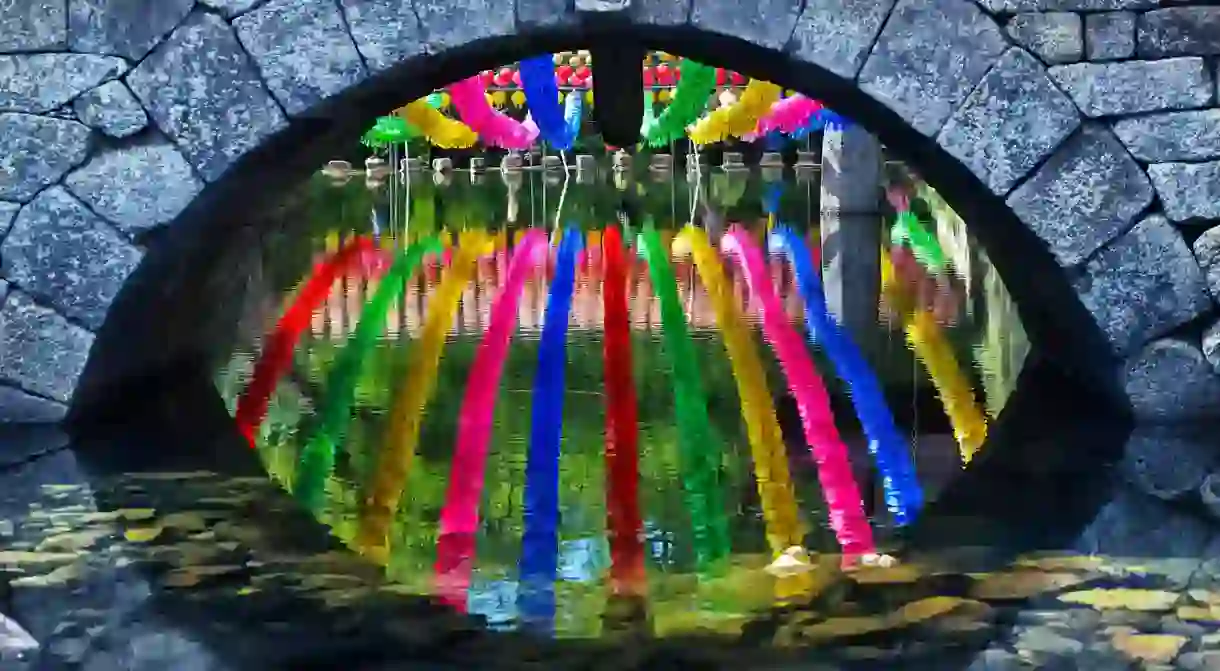The Most Beautiful Buddhist Sites in Daegu

Daegu is home to a number of important Buddhist sites, frequented by both practitioners of the religion and non-Buddhists alike. While each site boasts its own unique history and charm, the following are unquestionably the most beautiful.

Manbul Temple

More reminiscent of the temples of Thailand than Korea, Manbulsa is without a doubt one of the most unique temples on the peninsula. The jewel of the temple is its breathtaking lantern tower, which is adorned with three golden spires and a seemingly infinite number of miniature Buddhas. At the base of the lantern tower are stone statues of babies wearing red caps and holding small offerings of candy. Parents who have lost a child pay for these statues in an effort to offset negative karma.
Other highlights of Manbulsa include its three-story pagoda, the 33 m (108 ft) tall golden Amita Buddha and a maze bedecked with Buddhist scriptures on golden rolls. It is believed that spinning these rolls will help get rid of bad karma.
Other highlights of Manbulsa include its three-story pagoda, the 33 m (108 ft) tall golden Amita Buddha and a maze bedecked with Buddhist scriptures on golden rolls. It is believed that spinning these rolls will help get rid of bad karma.
Gatbawi Buddha

Perched on a cliff under Gwanbong Peak, the Gatbawi Buddha looks out over Palgongsan Provincial Park with an expression that is at once peaceful and powerful. The statue gets its name from the flat rock (bawi, in Korean) that sits atop its head and resembles a gat, or traditional Korean hat. The six meter tall Buddha is one of the most sophisticated statues from the ninth century that exists today, and was designated National Treasure No. 431 for its beauty and historical significance.
It is believed that the statue grants the requests of honest prayers, and is thus a popular spot with visitors, despite nearby precipitous drops. The site becomes especially crowded on New Year’s Day, when people flock to the statue to watch the sunrise and make a wish for the upcoming year.
It is believed that the statue grants the requests of honest prayers, and is thus a popular spot with visitors, despite nearby precipitous drops. The site becomes especially crowded on New Year’s Day, when people flock to the statue to watch the sunrise and make a wish for the upcoming year.
Donghwa Temple
Building

Also located deep in the woods of Palgong Mountain is Donghwa Temple, a complex that dates back to 493 C.E. Built by King Yongjo of the Goryeo dynasty, the complex’s main hall, Daeungjeon, boasts distinctive architectural details that create a harmony between the building and its surroundings. Vibrant wall paintings and pensive Buddhas adorn the structure’s interior.
In addition to a number of hermitage sites and eye-catching rock faces engraved with Buddhist iconography, Donghwasa is also home to the enormous Unification Medicine Buddha statue which stands 17 m (55.7 ft) high above the temple grounds.
In addition to a number of hermitage sites and eye-catching rock faces engraved with Buddhist iconography, Donghwasa is also home to the enormous Unification Medicine Buddha statue which stands 17 m (55.7 ft) high above the temple grounds.
Haein Temple

Shrouded in natural beauty, Haeinsa, located just outside Daegu, is an oasis of tranquillity and one of the most significant Buddhist sites in South Korea.
In addition to the Tripitaka Koreana, the oldest and most complete collection of Buddhist scriptures in the world, and Janggyeongpanjeon, the depositories that house the collection, some 200 public and private treasures are enshrined at Haeinsa Temple. The temple’s One Pillar Gate (Iljumun) is also considered as a representative work of ancient architecture. For these reasons, the site was appointed as a universal cultural heritage site in December 1995.
Visitors to the temple can not only get an up-close look at the complex’s cultural treasures, but can also opt to stay overnight to experience monastic life through a Templestay program.
In addition to the Tripitaka Koreana, the oldest and most complete collection of Buddhist scriptures in the world, and Janggyeongpanjeon, the depositories that house the collection, some 200 public and private treasures are enshrined at Haeinsa Temple. The temple’s One Pillar Gate (Iljumun) is also considered as a representative work of ancient architecture. For these reasons, the site was appointed as a universal cultural heritage site in December 1995.
Visitors to the temple can not only get an up-close look at the complex’s cultural treasures, but can also opt to stay overnight to experience monastic life through a Templestay program.
Gunwi Grotto Hermitage
Gunwi Grotto Hermitage is an artificial cave that was carved sometime between the sixth and eight centuries just outside of Daegu. It is among Korea’s oldest examples of Buddhist art and remains extremely well preserved, mostly thanks to the fact that it’s quite difficult to reach.
Housing three skillfully carved Buddha figures, the site was most likely inspired by similar grottos in India. Gunwi is also believed to be the source of inspiration for the bigger and better known Seokguram Grotto in Gyeongju, which was built at least a century later.
A modern marble staircase leads to the cave, but only monks are permitted to access it.
Housing three skillfully carved Buddha figures, the site was most likely inspired by similar grottos in India. Gunwi is also believed to be the source of inspiration for the bigger and better known Seokguram Grotto in Gyeongju, which was built at least a century later.
A modern marble staircase leads to the cave, but only monks are permitted to access it.













